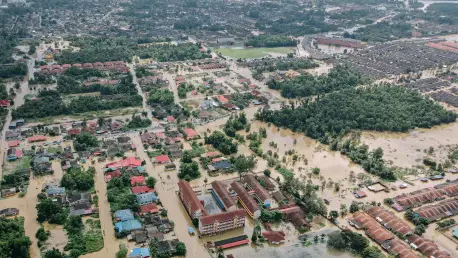As climate change intensifies, urban centers around the globe are grappling with an alarming reality: the escalating frequency and severity of extreme weather events are outpacing the financial and structural measures needed to protect them, leaving cities increasingly vulnerable. Insurers, often seen as the last line of defense against catastrophic losses, are sounding the alarm about a widening protection gap—the stark difference between the damages caused by climate-related disasters and the coverage available to mitigate those losses. This gap threatens not only the economic stability of cities but also their long-term insurability, potentially leading to capital flight and diminished resilience. With premiums soaring and coverage becoming scarce in high-risk areas, the message is clear: cities must act decisively to integrate resilience into their planning. The role of insurers in this evolving landscape is shifting from mere payout providers to strategic partners in risk management, urging a collaborative push toward sustainable urban futures.
Climate Challenges Threaten Urban Stability
The mounting risks posed by climate change are reshaping the financial landscape for cities worldwide, with insurers highlighting a troubling trend of increasing exposure to extreme weather events like floods, storms, and heatwaves. These events are driving up the cost of property insurance, often rendering it unaffordable or entirely unavailable in vulnerable regions. When coverage becomes out of reach, local governments and residents are left exposed to devastating financial losses after disasters, hampering recovery efforts and threatening long-term economic viability. The implications are profound, as uninsurable cities risk losing investor confidence, which could trigger a downward spiral of declining property values and reduced capital inflows. Insurers are increasingly vocal about the need for systemic change, pointing out that without proactive measures to bolster resilience, the protection gap will continue to widen, leaving urban areas ill-equipped to handle the growing challenges posed by a changing climate.
Beyond the immediate financial strain, the ripple effects of reduced insurance availability are becoming evident in urban planning and development strategies. As premiums rise by staggering percentages in some areas, municipalities are forced to reassess how they allocate limited budgets, often at the expense of other critical services. The stark reality is that failing to address climate risks now could lead to a future where entire communities are deemed too risky to insure, effectively cutting them off from the economic safety net that insurance provides. This scenario underscores the urgency for cities to prioritize adaptive infrastructure and risk mitigation, aligning their policies with the data-driven insights that insurers can offer. By focusing on long-term resilience rather than short-term fixes, urban leaders can work to maintain insurability, ensuring that their cities remain attractive to businesses and residents alike despite the escalating threats posed by environmental shifts.
Innovative Strategies for Building Resilience
Amid these challenges, several cities are pioneering approaches to enhance their resilience and secure insurance coverage through strategic investments and governance reforms. Take Broward County, Florida, for instance, where a dramatic surge in flood insurance premiums prompted local officials to channel funds into robust flood defenses. This initiative not only reduced exposure to flooding but also demonstrated tangible economic benefits, gaining support from businesses and unlocking alternative funding streams. Such proactive measures highlight the value of leveraging risk modeling and insurance data to guide capital allocation, ensuring that investments target the most pressing vulnerabilities. By showcasing the return on investment in resilience, these efforts serve as a blueprint for other urban areas struggling with similar climate-driven financial pressures, proving that strategic planning can preserve insurability.
Similarly, Cape Town, South Africa, has emerged as a model for embedding resilience into city governance, enhancing both its insurability and creditworthiness. Through transparent reporting and continuous risk assessments, the city has attracted international financing to support adaptation projects, demonstrating how accountability can draw capital. Meanwhile, in Canada, the Municipal Fund has mobilized substantial public and private investment to de-risk resilience initiatives across thousands of projects, offering a scalable framework for other regions. These diverse examples collectively illustrate a critical trend: urban areas that adopt a data-driven, collaborative approach are better positioned to retain insurance capacity and secure economic stability. The success of these strategies lies in their ability to align local priorities with the expectations of insurers and investors, creating a mutually beneficial environment for sustainable growth in the face of climate uncertainty.
Insurers as Partners in Risk Management
Insurers are increasingly urged to transcend their traditional role of processing claims and become active collaborators in urban risk management, a shift that could redefine how cities prepare for climate impacts. Industry leaders emphasize that early engagement with municipalities allows for better quantification of exposure, enabling more informed investment decisions and stabilizing insurance pricing over time. This evolving partnership positions insurance not just as a financial backstop but as a catalyst for sustainable urban development, encouraging cities to prioritize adaptive infrastructure. By integrating resilience into their long-term strategies, insurers can help mitigate the risk of market withdrawals in high-risk areas, where the absence of coverage could exacerbate affordability issues. This proactive stance is essential for maintaining a balance between risk transfer and urban planning, ensuring that cities remain viable in an era of heightened environmental threats.
Furthermore, the concept of pricing resilience into insurance models is gaining traction as a mechanism to incentivize preparedness among urban stakeholders. When insurers factor in a city’s commitment to adaptive measures, it creates a financial impetus for municipalities to invest in infrastructure that reduces vulnerability, potentially lowering premiums and expanding coverage options. This approach also aligns with the broader need for predictability and stability, which benefits both insurers and investors seeking to support urban growth. As climate risks continue to evolve, the collaboration between insurers and cities must deepen, focusing on shared goals of risk reduction and economic safeguarding. Such partnerships can bridge the gap between data, finance, and actionable policy, fostering an environment where urban resilience is not just a goal but a measurable outcome that sustains communities through inevitable climate challenges.
Pathways to Sustainable Urban Futures
Reflecting on the mounting evidence, it becomes evident that the widening protection gap poses a significant barrier to urban sustainability, driven by escalating climate risks and insufficient funding for resilience. Cities that have lagged in prioritizing adaptive measures often find themselves grappling with unaffordable insurance or complete market withdrawal, amplifying recovery struggles after disasters. Yet, those that have embraced innovative financing and partnerships with insurers manage to navigate these hurdles, retaining coverage and economic stability even amidst severe weather events. The lessons from these past efforts underscore a vital truth: proactive planning and collaboration are indispensable in countering the financial fallout of climate exposure.
Looking ahead, the focus must shift to scalable solutions that integrate resilience into the core of urban development. Governments, insurers, and private sectors should align resources to support data-driven adaptation, ensuring that cities can access the capital needed for transformative infrastructure. Strengthening governance frameworks to prioritize transparency and measurable outcomes will further attract investment, while global platforms like upcoming climate finance negotiations can amplify these efforts. By fostering systemic change through shared expertise and strategic funding, urban areas can build a foundation for enduring resilience, turning the daunting challenges of climate risks into opportunities for sustainable progress.









